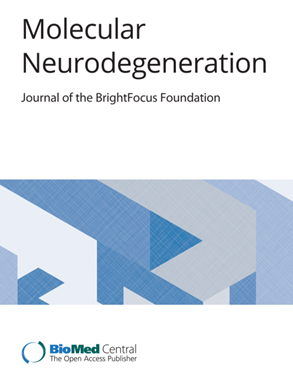脑脊液中可溶性 TREM2 的蛋白质基因组学提供了新见解,并确定了治疗阿尔茨海默病的新型调节剂
IF 14.9
1区 医学
Q1 NEUROSCIENCES
引用次数: 0
摘要
髓系细胞上表达的触发受体 2(TREM2)在小胶质细胞活化、存活和凋亡以及阿尔茨海默病(AD)发病机制中发挥着关键作用。我们曾报道 MS4A 基因座是脑脊液(CSF)中可溶性 TREM2(sTREM2)的关键调节因子。为了鉴定 sTREM2 的其他新型遗传调节因子,我们进行了最大规模的全基因组关联研究(GWAS),在 3,350 名欧洲血统的个体中鉴定出了 CSF sTREM2 的四个基因位点。通过多种族精细作图,我们确定了两个独立的错义变异(MS4A4A 中的 p.M178V 和 MS4A6A 中的 p.A112T),它们驱动了 MS4A 位点的关联,并显示出对 sTREM2 水平和 AD 风险的表观效应。位于chr 6上的新TREM2位点包含两个与sTREM2和AD风险相关的罕见错义变异(rs75932628 p.R47H,P=7.16×10-19;rs142232675 p.D87N,P=2.71×10-10)。TGFBR2和RBMS3基因区的第三个新位点(rs73823326,P=3.86×10-9)包括一个TGFBR2启动子小胶质细胞特异性染色质环的调控变异。通过基于细胞的实验,我们证明过表达和敲除 TGFBR2(而非 RBMS3)会导致 sTREM2 发生显著变化。最后一个新基因位点位于 APOE 区域(rs11666329,P=2.52×10-8),但我们证明这一信号与 APOE 基因型无关。这一信号与大脑皮层中 NECTIN2 的顺式-eQTL 和 CSF 中 NECTIN2 的顺式-pQTL 共同定位。NECTIN2的过表达导致sTREM2的增加,支持了遗传学的发现。据我们所知,这是迄今为止旨在确定 CSF sTREM2 遗传修饰因子的最大规模研究。这项研究为MS4A和TREM2基因位点(两个众所周知的AD风险基因)提供了新的见解,并确定了TGFBR2和NECTIN2是参与TREM2生物学的额外调节因子。本文章由计算机程序翻译,如有差异,请以英文原文为准。
Proteo-genomics of soluble TREM2 in cerebrospinal fluid provides novel insights and identifies novel modulators for Alzheimer’s disease
Triggering receptor expressed on myeloid cells 2 (TREM2) plays a critical role in microglial activation, survival, and apoptosis, as well as in Alzheimer’s disease (AD) pathogenesis. We previously reported the MS4A locus as a key modulator for soluble TREM2 (sTREM2) in cerebrospinal fluid (CSF). To identify additional novel genetic modifiers of sTREM2, we performed the largest genome-wide association study (GWAS) and identified four loci for CSF sTREM2 in 3,350 individuals of European ancestry. Through multi-ethnic fine mapping, we identified two independent missense variants (p.M178V in MS4A4A and p.A112T in MS4A6A) that drive the association in MS4A locus and showed an epistatic effect for sTREM2 levels and AD risk. The novel TREM2 locus on chr 6 contains two rare missense variants (rs75932628 p.R47H, P=7.16×10-19; rs142232675 p.D87N, P=2.71×10-10) associated with sTREM2 and AD risk. The third novel locus in the TGFBR2 and RBMS3 gene region (rs73823326, P=3.86×10-9) included a regulatory variant with a microglia-specific chromatin loop for the promoter of TGFBR2. Using cell-based assays we demonstrate that overexpression and knock-down of TGFBR2, but not RBMS3, leads to significant changes of sTREM2. The last novel locus is located on the APOE region (rs11666329, P=2.52×10-8), but we demonstrated that this signal was independent of APOE genotype. This signal colocalized with cis-eQTL of NECTIN2 in the brain cortex and cis-pQTL of NECTIN2 in CSF. Overexpression of NECTIN2 led to an increase of sTREM2 supporting the genetic findings. To our knowledge, this is the largest study to date aimed at identifying genetic modifiers of CSF sTREM2. This study provided novel insights into the MS4A and TREM2 loci, two well-known AD risk genes, and identified TGFBR2 and NECTIN2 as additional modulators involved in TREM2 biology.
求助全文
通过发布文献求助,成功后即可免费获取论文全文。
去求助
来源期刊

Molecular Neurodegeneration
医学-神经科学
CiteScore
23.00
自引率
4.60%
发文量
78
审稿时长
6-12 weeks
期刊介绍:
Molecular Neurodegeneration, an open-access, peer-reviewed journal, comprehensively covers neurodegeneration research at the molecular and cellular levels.
Neurodegenerative diseases, such as Alzheimer's, Parkinson's, Huntington's, and prion diseases, fall under its purview. These disorders, often linked to advanced aging and characterized by varying degrees of dementia, pose a significant public health concern with the growing aging population. Recent strides in understanding the molecular and cellular mechanisms of these neurodegenerative disorders offer valuable insights into their pathogenesis.
 求助内容:
求助内容: 应助结果提醒方式:
应助结果提醒方式:


